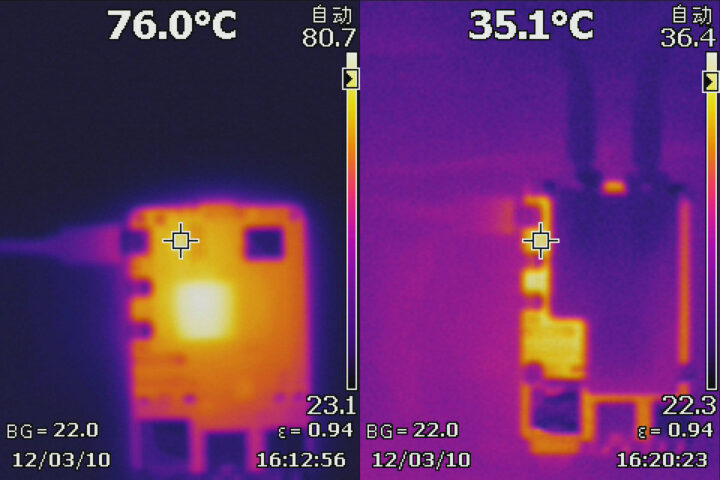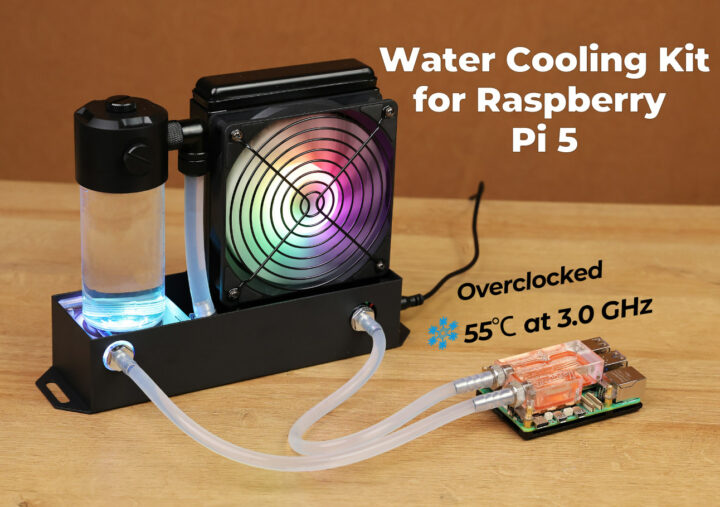If you like fancy, but somewhat expensive and useless things, 52Pi’s water cooling kit for Raspberry Pi 5 SBC may be right up your alley and the over-engineered cooling solution sells for $120 on Seeed Studio where we discovered the kit.
We’ve already seen the active cooler and official case do a decent job at cooling the Raspberry Pi 5, but several companies have also launched fanless cases for the latest Pi single board computer. Water cooling may only make sense when attempting to overclock the Raspberry Pi 5, and 52Pi claims the Broadcom BCM2712 processor can run a 3.0 GHz at a relatively cool temperature of 55°C.
52Pi water cooling kit content:
- Main water cooling unit with RGB LED fan, water tank, and base
- Water cooling radiator (that’s the orange thing on top of the Raspberry Pi)
- Black heatsink
- 2x Silicone hoses
- 12V/2A power adapter (US)
- 4x M2.5*10 hexagonal screws
- L-key hex wrench

Besides the CPU temperature going only up to 55°C at 3.0 GHz, the temperature is said to hover around 37°C under full load at the stock 2.4 GHz frequency. I could not find mounting and usage instructions on Seeed Studio or the 52Pi website at the time of writing, but Leepsvideo got a unit, and you can learn how to assemble it from his video review.
It’s not the first silly cooling solution from 52Pi, as we previously reviewed the 52Pi ICE Tower cooling fan for the Raspberry Pi 4.

Jean-Luc started CNX Software in 2010 as a part-time endeavor, before quitting his job as a software engineering manager, and starting to write daily news, and reviews full time later in 2011.
Support CNX Software! Donate via cryptocurrencies, become a Patron on Patreon, or purchase goods on Amazon or Aliexpress







> 52Pi claims the Broadcom BCM2712 processor can run a 3.0 GHz at a relatively cool temperature of 55°C
In which load scenario? Idle? I mean… RPi guys got DVFS right as such even if the RPi 5 is allowed to run at 3.0 GHz in idle it will clock at 1500 MHz @ 720 mV (after minor adjustments) and be just fine.
Anyway: this is ‘sbc-bench -c’ at actual 3000 MHz, max temp 37.5°C with cooling setup for ~12 bucks: http://sprunge.us/VXJQVO
https://i.postimg.cc/BZCxwRW9/IMG-2819-klein.jpg
I was thinking the same, totally overkill solution. But when you see the RGB leds on the fan and the light under the water tank, you quickly realize that it’s designed for fanboys who want to impress their friends with their extreme solution that allows them to overclock their RPi, even if it’s not needed 🙂 So the price is right in this case 🙂
Jerry probably has one on order!
No, Jerry knows that RPi doesn’t need overclocking, it’s already fast enough for everything!
The radiator has a fan attached to it. The part mounted on the RPi is the water block. Smh
A nicer build, more compact by FrostByte -and without RGB. Might come in handy when crunching ARM projects on BOINC 24/7/365 in a warm climate.
> Might come in handy when crunching ARM projects on BOINC 24/7/365 in a warm climate
Why/how? The basic principle of such water coolers is to dissipate heat efficiently out of a cramped enclosure to be combined with an external radiator.
That’s nonsense with thingies that small as an SBC since you simply encase them with a giant heat spreader (a metal enclosure designed to act as heatsink like pictured above) and add then some lateral airflow to the setup. Water can’t improve here anything…
>Water can’t improve here anything…
What water improves is only the dissipation area when it circulates inside a wide radiator that has more surface than the one you place the board in. I think that they can realistically achieve a few less degrees with their huge blinking tower than what you get with the efficient sandwich type, but that’s total nonsense anyway because it’s way overkill. It’s as large as what one would use to dissipate the heat from a 300W GPU, for a chip that probably peaks at no more than 10-15W when heavily overclocked.
> for a chip that probably peaks at no more than 10-15W when heavily overclocked.
10-15W? Are you kidding? 🙂
RPi 5 with latest default settings idles here at slightly above 3W (measured at the wall, their new 27W-PSU included and yeah, that’s way too high) and at 3 GHz when running a rather heavy benchmark it doesn’t exceed 10W so BCM2712 can not even burn 7W.
BTW: they did DVFS wrong (as almost expected):
https://i.postimg.cc/BbqmhKQD/Bildschirmfoto-2024-01-26-um-18-12-58-klein.png
I was just guessing, having never tried it and not knowing how much overvoltage is needed to reach 3 GHz. Based on your graph showing a linear consumption, it seems that the chip’s voltage isn’t changed ? So maybe this chip is natively 3 GHz and sold as 2.4 to keep some margin.
In any case, the whole board’s consumption has to be taken in to account for SBC cooling, because the cooling solution must eliminate all this heat given that everything that’s produced on the PCB inevitably heats the SoC and heat sink as well.
Overall the graphs are impressive. I used to torture my old RK3288 way beyond that to reach just 2.13 GHz, sometimes seeing short peaks at 3.5A under 5V 🙂
How do you feel about this board for now ? Does it feel fast ? It seems the memory benchmarks are correct now, these used to be a weak point of older models. I was wondering if it could make sense to get one with 16G RAM to run some small LLMs but I’m seeing that they’re only making a 8G one max, so for now that’s pointless anyway.
> Based on your graph showing a linear consumption, it seems that the chip’s voltage isn’t changed?
I added a function to derive the DVFS OPP tables just now in sbc-bench (we need to query ThreadX for each OPP) and it looks like they implement it in a weird way as some function: per every 100 MHz the voltage differences are larger at lower cpufreqs which doesn’t make much sense, e.g. with arm_freq=3000 set it looks like this:
It looks like 0.14mV / MHz rounded to the closest multiple of 5mV. For the lowest value, it’s likely because the propagation delays allow the chip to run below transistor saturation at 1.5 GHz, which then makes it possible to operate at an even lower voltage with slower ramp-ups. Transitions consume less as the short-circuit current during the transition is much lower.
I now set arm_freq=1800 and arm_freq_min=100 in config.txt, rebootet and now we’re here: the lowest allowed cpufreq which is 200 MHz at the moment being at 720 mV, 1500 MHz now being driven with 840 mV and the top 1800 MHz at 865 mV instead of 790 mV as before).
It seems that those DVFS OPP are not hardware properties but just the result of some algorithm running in the ThreadX closed source world beyond our control…
Now with arm_freq_min=1500 and arm_freq=1800 the lowest cpufreq gets 720 mV as always and 1800 MHz are fed with 870 mV:
Makes not that much sense IMO…
I agree. That’s odd. They indeed seem to be calculating a slope and apply it to the configured range without making much sense.
So it takes up 10x the space and doubles your power usage just for cooling a low power computer. SMH
> just for cooling
That should read ‘just for very inefficiently cooling’ since 55°C at 3.0 GHz is a joke even ‘under full load’ and taking into account that w/o knowing ambient temperature all these thermal numbers are BS anyway…
Yeah I agree, that’s ridiculous, but some jerks are very likely going to buy it because it’s certainly better that who-knows-what. Also, the chip is apparently spec’d for 88°C so who cares about their 55°C “achievement” ? Wasting watts to increase the temperature margin is just useless.
Also as seen on the video, the heat spreader on top of the CPU isn’t suited for that design because it’s totally flat while chips all have different thicknesses 🙂
Could be fixed with a few sponges, but yeah. This is crap